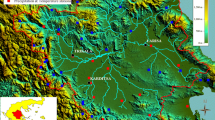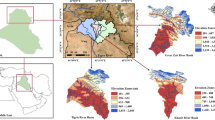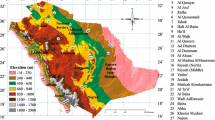Abstract
Climate change affects the patterns of precipitation and evapotranspiration and therefore can affect the future water availability and its spatial and temporal distribution. Climate change is also likely to intensify the global hydrological cycle, which can increase the risk of floods and droughts. This study focuses on Kabul basin which lies in the northeast quarter of Afghanistan. It accounts for thirty-five percent of the population’s water supply, and has the fastest population growth rate in the country. The main objective of this study is to assess the impacts of climate change on water resources. The climate projections are regionally available at finer resolution. Here in this study the future precipitation data were obtained from the selected models available from the Coordinated Regional Downscaling Experiment (CORDEX) program of the South Asian domain. The APHRODITE precipitation and temperature datasets were also used as observations in the lack of in situ measurements for the data-scarce Kabul basin. The SWAT hydrological model was then developed to understand hydrologic response of the Kabul basin and future projections of water availability under future climate scenarios. The median of the results from all used RCMs suggests an increasing trend in maximum and minimum temperature in the future, as compared to the baseline while the projections for precipitation mainly show a decreasing trend under both RCPs. Based on the results of hydrological modeling, the future runoff would likely increase due to the increased snowmelt in the study area. However lack of infrastructures might lead to further problems due to the possibility of more frequent and extreme floods and droughts.
Access provided by Autonomous University of Puebla. Download conference paper PDF
Similar content being viewed by others
Keywords
1 Introduction
Afghanistan is a semi-arid and mountainous country which faced three decades of conflict. It is one of the most vulnerable countries in the world to climate change as it has very limited capacity to address the impacts of climate change. It has been also considered as a data-scarce region both temporally and spatially with limited capability to measure hydro-meteorological parameters with in situ gauges. The current study focuses on Kabul basin which is surrounded by mountains located in the eastern and central part of the country. The Afghan capital is located in this basin and the main river here is called the Kabul River, which is the most important (although not the largest) river in Afghanistan. Much of the discharge of the Kabul River results from the melting snow accumulating during the winter season in the mountains. However, winter rains, which are common in late winter and early spring, falling on a ripe snow pack in the highlands can greatly augment the flow of the main streams [6].
For hydrological applications, it is essential to quantify precipitation. The availability of satellite-based precipitation products and gridded interpolated datasets provides a great opportunity for those regions suffering from poor spatial and temporal sampling of precipitation. Ghulami et al. [3] tested the estimates from four precipitation products and showed a relatively good detection of precipitation distribution and precipitation amounts for most cases. Their results of continuous and categorical verification statistics suggested that the APHRODITE dataset performed better than other gridded datasets tested for the study basin.
Understanding the impacts of climate variability/changes on different sectors (such as hydropower, irrigation and agriculture, water supply, and sanitation) may lead to more flexible development plans to adapt to these changes and mitigate their impacts. It is an important step which needs to be investigated. Thus, for a country like Afghanistan, in which a majority of its population is engaged in agricultural activities, a lack of understanding about climate change impacts is a very significant problem and needs to be addressed. Therefore, the current study is done to analyze the hydrological response of the Kabul basin and the impacts of climate change on its water resources using the regional scale climate projections of precipitation and temperature.
2 Methods
2.1 Study Area
The Kabul River includes all Afghan rivers that join the Indus River in Pakistan. The Indus empties into the Arabian Sea of the Indian Ocean. The Kabul basin covers twelve percent of the national territory of Afghanistan, but alone it drains one-fourth (twenty six percent) of the total annual water flow of the country. As per the information obtained from the Afghanistan Central Statistics Organization (CSO), provinces in the Kabul basin account for thirty five percent of the nation’s population, and this region has the fastest population growth rate in the country.
In this study, the Kabul basin has been divided into four main subbasins, which are shown in Fig. 50.1. The total area of the basin is almost 69,269 km2 and the main subbasins and outlets are described in Table 50.1. Figure 50.2 shows the long-term average of precipitation and temperature values for the basin.
2.2 Data Availability
While Afghanistan’s meteorological stations were established during the 1950s, once the conflict started, data recording stopped almost everywhere. Data collection activities gradually restarted after 2003. In the lack of long-term surface observations, here in this study, APHRODITE MA (Asian Precipitation Highly Resolved Observational Data Integration Towards Evaluation of water resources, Monsoon Asia (V1101)) was used. APHRODITE MA is an interpolated dataset from rain gauge locations. Depending on availability, between 5,000 and 12,000 rain gauge locations are considered for interpolation. These daily data cover a period of more than 50 years (1951–2007) with a spatial resolution of 0.25°. The interpolation algorithm incorporates orographic correction of precipitation [8].
For this study, a Multi-RCMs approach was used to identify the uncertainty in a climate change model for predictions of future precipitation and temperature for the Kabul basin (Table 50.2).
The landscape features (Fig. 50.3) for hydrological modeling were also obtained from different sources:
-
DEM
The 90-m resolution Digital Elevation Model (DEM) was downloaded from the CGIAR-CSI website: http://srtm.csi.cgiar.org/SELECTION/inputCoord.asp. Based on this map, the highest elevation of the Kabul basin is 7603 masl and the lowest is 401 masl.
-
Soil
The Harmonized World Soil Database (HWSD), combined with the USDA soil map, was used to specify the soil types of the basin.
-
Land use
The Globcover 2009 Map of the European Space Agency (ESA) was applied to specify the different land use and land cover types. For the glacier extent of the basin, the map provided by International Centre for Integrated Mountain Development (ICIMOD) was used.
2.3 SWAT Hydrological Model
The Soil and Water Assessment Tool (SWAT) is a processed-based, semi-distributed watershed scale simulation model developed initially for the large-scale watersheds [1]. It considers the Hydrological Response Units (HRUs) as model entities. This is done by overlaying the land use, soil and slope layers and finding their unique combinations. The potential evapotranspiration is calculated by Penman-Monteith and runoff estimated with curve number method. A summary of the methods used and parameters required to simulate processes of the water component of SWAT model is shown in Table 50.3 [2].
2.4 Downscaling of Climate Data
The delta change approach is a method to downscale global/regional climate model data so that this data may be used as an input for hydrological models and even flood risk assessment for the future. Climate model outputs have inadequacies and a common approach to deal with that issue is the delta change method. This method computes differences between current and future GCM/RCM simulations and adds these changes to the observed time series. The delta change method is the primary future scenario generation technique suggested for use in the U.S. National Assessment. The constraint of this approach is that it is not suitable for non-normal distributions or for analyzing extreme events [7]. Applying the delta change method assumes that GCMs/RCMs more reliably simulate relative changes rather than absolute values [4].
3 Results
3.1 Future Projections of Precipitation and Temperature
The RCMs’ values were compared with their baseline observations (1986–2005) for each month and the changes were calculated for the whole Kabul basin. Figure 50.4 shows the median of all 6 downscaled RCMs. The results suggest an increasing trend in maximum and minimum temperature in the future, as compared to the baseline. The increases for maximum temperature range from +1.05 °C to +3.13 °C under RCP 4.5 and +0.85 °C to +5.83 °C under RCP 8.5. The increases for minimum temperature range from +0.63 °C to +2.94 °C under RCP 4.5 and +0.63 °C to +5.23 °C under RCP 8.5. The projections for precipitation suggest a decreasing trend in the winter precipitation under both RCPs 4.5 and 8.5 while the summer precipitation in most cases are on the increase.
3.2 Calibration and Validation of the SWAT Hydrological Model
The input data for the calibration and simulation periods were selected based on the availability of data from 1969–1977. The model has a number of calibration parameters that have to be adapted during the model application. The list of the selected calibration parameters is provided in Table 50.4.
The results of monthly simulations for the calibration period (1969–1977) periods, along with the model’s efficiencies, are shown in Fig. 50.5. The red and blue lines represent simulated and observed streamflow discharges, respectively. The results are shown only for the main outlet of the basin at Dakah station. The monthly mean precipitation (blue bars) is given in upper panel. During the calibration period, the model is able to reproduce overall hydrological responses fairly well, on the basis of results given in the graphical and statistical evaluations.
3.3 Future Changes of Water Availability
The simulations’ results of future runoff were compared with the results of the models for the baseline period of 1986 to 2005. Figure 50.6 shows future runoff for each future time period compared to the baseline under different RCP scenarios based on all used RCMs. Overall, the results suggest that future runoffs are very likely to increase. This is mainly due to the increase in temperature which in turn causes an increase in snowmelt. Iqbal et al. [5] studied the impact of climate change on flood frequency and intensity in the Kabul River basin and suggested that the future floods would increase due to an increasing precipitation and higher temperatures, based on most of the climate models, which they used.
The predictions for future runoff range between −6% to +43% over the 21st century under RCP 4.5 while these changes are predicted to be within −13% to +78% under RCP 8.5 for the same period. However, the median values show much lesser range and vary between −4% to +21%.
Figure 50.7 shows the changes in predicted surface runoff and baseflow for the future as well as actual evapotranspiration in the Kabul basin, as compared to the baseline period. The trend shows that though future runoff is increasing, this increase is mainly happening in surface runoff while the baseflow might actually decrease.
4 Conclusions
Climate change affects the patterns of temperature and precipitation. As a result, other variables, such as water availability and its spatial and temporal distributions also get affected. The median of the results from all 6 RCMs used in this study, suggests an increasing trend in maximum and minimum temperature in the future, as compared to the baseline. The projections for precipitation suggest a decreasing trend in the winter precipitation while the summer precipitation in most cases are on the increase.
The results of SWAT hydrological model during the calibration period suggest that the model performed well and can be used to reproduce the hydrological response of the basin. As per the predictions, future runoff ranges between −4% and +21%. This increase is mainly due to the increase in temperature and thus the snowmelt.
References
Arnold JG, Srinivasan R, Muttiah RS, Williams JR (1998) Large area hydrologic modeling and assessment, part 1: model development. JAWRA 34(1):73–89
Arnold JG, Fohrer N (2005) SWAT2000: Current capabilities and research opportunities in applied watershed modelling. Hydrol. Processes 19(3):563–572
Ghulami M, Babel MS, Shrestha MS (2017) Evaluation of gridded precipitation datasets for the Kabul Basin, Afghanistan. Int J Remote Sens 38(11):3317–3332
Hay LE, Wilby RL, Leavesley GH (2000) A comparison of delta change and downscaled GCM scenarios for three mountainous basins in The United States. J Am Water Resour Assoc 36(2):387–397
Iqbal M, Dahri Z, Querner E, Khan A, Hofstra N (2018) Impact of climate change on flood frequency and intensity in the Kabul river basin. Geosciences 8(4):114
Lashkaripour GR, Hussaini SA (2007) Water resource management in Kabul river basin, eastern Afghanistan. Environmentalist 28(3):253–260
Trzaska S, Schnarr E (2014) A review of downscaling methods for climate change projections. United States agency for international development by Tetra Tech ARD, September 2014, pp 1–42
Xie P, Chen M, Yang S, Yatagai A, Hayasaka T, Fukushima Y, Liu C (2007) A gauge-based analysis of daily precipitation over East Asia. J Hydrometeorol 8(3):607–626
Acknowledgements
We would like to express our sincere gratitude to the various regional and international agencies for providing the data required for this study.
Author information
Authors and Affiliations
Corresponding author
Editor information
Editors and Affiliations
Rights and permissions
Copyright information
© 2020 Springer Nature Singapore Pte Ltd.
About this paper
Cite this paper
Ghulami, M., Gourbesville, P., Audra, P. (2020). Assessing Future Water Availability Under a Changing Climate in Kabul Basin. In: Gourbesville, P., Caignaert, G. (eds) Advances in Hydroinformatics. Springer Water. Springer, Singapore. https://doi.org/10.1007/978-981-15-5436-0_50
Download citation
DOI: https://doi.org/10.1007/978-981-15-5436-0_50
Published:
Publisher Name: Springer, Singapore
Print ISBN: 978-981-15-5435-3
Online ISBN: 978-981-15-5436-0
eBook Packages: Mathematics and StatisticsMathematics and Statistics (R0)











